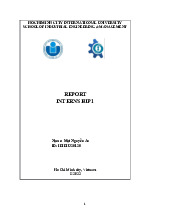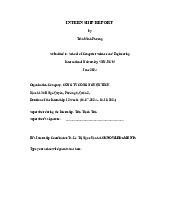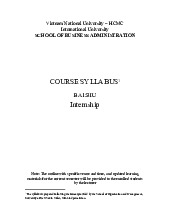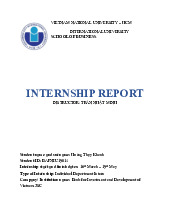



















Preview text:
HO CHI MINH CITY INTERNATIONAL UNIVERSITY
SCHOOL OF INDUSTRIAL ENGINEERING & MANAGEMENT REPORT INTERNSHIP 1
Name: Trần Hải Đăng ID: IELSIU20012 Ho Chi Minh city, Vietnam Month/Year TABLE OF CONTENTS
Students have to report 5 compan
describes ies which ha general inf ve ormation
already visited. Each company student should clarify about as below: I. INTRODUCTION (
company which can get info when company introduce
or find more on internet)
describes what you already observe II. OBSERVATION (
such as production process, checking process,
material flow, ….)
based on what you have learned in school III. ANALYSIS (
then you analysis what you have seen on visiting and
give some improvement ideas)
what lessons you have learned from IV. CONCLUSION ( this visiting) A. INTRODUCTION Table of Contents
A.Introduction…………………………………………….……3
B. General……………………………………………………. …3 C. Company
description…………………………………….….4
1. TBS group-Multi-industry company……………………………
a) Introduction…………………………………………………..….4
b) Observation………………………………………………….…..5
c)Analysis and lesson learned……………………………………...8
2. YAKULT Vietnam……………………………………………...9
a)Introduction……………………………………………………..9
b) Observation…………………………………………………....10
c) Analysis and lesson learned………………………………..….12 3. AJINOMOTO
Vietnam………………………………………………………...13
a) Introduction……………………………………………………13
b) Observation……………………………………………………14
c) Analysis and lesson learned…………………………………...15
4. TRA-SAS Joint Stock Company
company…………………………………………………….…16
a) Introduction……………………………………………………16
b) Observation……………………………………………..…..…17
c)Analysis and lesson learned…………………………………....18
D. Conclusion…………………………………………...20
E. References……………………………………………21
With the goal of strengthening the knowledge and experience of the
students of the Faculty of Industrial Systems Engineering,
internship 1 is an important stepping stone to help students have a
perspective on businesses and their own careers.
During the last summer (2022-2023), we had the opportunity to visit
and experience 4 companies including: YAKULT, AJINOMOTO
(food and chain company) and TBS group, TRASAS (food industry
group) household as well as focusing on logistics).
Under the guidance of the instructors, we were able to visualise and
understand the actual problems of the industry, the relationship
between machines and human resources. This report is intended to
summarise what I have learned after the field trips to self-realise my
knowledge and abilities. Above all, thank you to everyone who has
tried their best to guide students like me this semester. B. GENERAL
This report is about 4 factory companies, respectively:
● TBS group-Multi-industry company (shoes, bags, logistics)
● YAKULT Vietnam (Production of fermented drinks)
● AJINOMOTO Vietnam(Production of spices)
● TRA-SAS Joint Stock Company company( Customs declaration and cargo agent) C. COMPANY DESCRIPTION TBS group 1. INTRODUCTION
-"The world can do it, so we can do it" are the words that Mr.
Nguyen Duc Thuan - who was born in a moneyless family of
teachers, always takes to heart. When he reached adulthood, along with two companions, Nguyen Thanh Son and Cao Thanh Bich,
to found the company TBS group.
In 1992, the Thai Binh shoes No.1 factory was approved to go into
operation. Following the development, factory No.2 was also put
into operation with the mission of focusing on sports shoes. After
the Certificates of Merit for Typical Enterprise in Vietnam Textile &
Garment & Footwear industry awarded by the Ministry of Industry
and Trade in 2009, the company expanded into the handbag industry
in 2011. After more than 30 years of development, the TBS group
has now assembled, enter the international market in many new
fields such as logistics and trade in services.
- Company: Thai Binh Joint Stock Company
- Factories: 35 factories spread across Vietnam (North, Central, East, West)
- Research Centre: 6 centres specialising in research and development of new products - Distribution: Viet Nam
- Familiar partner of many big brands in the world such as:
Decathlon, Skechers and Wolverine
- Vietnamese company with standard capacity, international vision
- Main consumption markets: Europe, America, Japan
- Current manpower: 17,000 people 2. OBSERVATION
- August 18, 2015, The inauguration ceremony of Warehouse 5
was officially held in Binh Duong
- Total area up to 47,500 m2
❖The process of receiving and checking goods is strictly carried out
according to the following steps:
Step 1(Inbound receiving): Drivers do registration procedures at
the gate Step 2: Staff in the centre will document and verify. The data will be uploaded to the WMS management system
Step 3: The car has been brought into the warehouse,, then the
security guard will check the basic information about the type of
goods and seal it if it is not.
Step 4: Cargo handling, verification and labelling
Step 5: WMS records the location of each package
Step 6(Pick and pack processing): Goods are passed through the check code scanning area Step 7: Reseal new packing Step 8(Outbound loading): Check empty containers according to CT-PAT .'s seven- step process Step 9: Container Sealing
(Including customer and supplier). Seal photo take
Step 10: Cargo deliver to terminal
3. ANALYSIS and LESSON LEARNED
In the context of many changes in the economy of Vietnam and the
world, the implementation and signing of new-generation free trade
agreements such as CPTPP, EVFTA, and RCEP bring many
advantages and challenges for businesses. Vietnam.
Logistics costs of TBS logistics compared to developed countries in
the world are still too high. This is because industries and
infrastructure do not have close links and mutual support. This leads
to a decrease in the competitiveness of Vietnamese goods in the
international market. The next issue we can mention is the quality of
human resources. TBS logistics as well as other logistics companies
in Vietnam are always in a shortage of high-quality human
resources, making it difficult to compete with foreign enterprises in
terms of scale and uniformity.
Once the opportunities and challenges have been identified, there
must be clear code improvement steps:
● Focus on perfecting the system of regulations, mechanisms
and policies related to logistics
● Prioritise resources to improve infrastructure and promote logistics development
● Government support is needed in policies and financial
priorities from the Ministry of Industry and Trade to help
businesses develop peace of mind.
● The most important thing is to strengthen training, raise
awareness and quality of human resources. Yakult company 1. INTRODUCTION
- The origin of the Yakult company was
when Dr. Minoru Shirota successfully
isolated and cultured a new strain of
lactic acid bacteria, Lactobacillus
casei Shirota. In 1935, the Yakult
company first commercialised in the
Japanese market. In 1955, Yakult
Honsha Company was established.
The research centre was established in Kyoto. In 2007, Yakult
came to the Vietnam market, the factory in Binh Duong
officially went into operation one year later. As of 2022,
Yakult is present in 38 countries on multiple continents. - Company: Yakult Honsha
- Product: Fermented beverages, food and cosmetics
- Distribution: 38 countries (Asia, Europe, South America, North America and Australia)
- Research Centre: 2 Yakult microbiology research institutes located in Japan and Belgium
- Yakult's General Philosophy: Longevity, Preventive Medicine, Reasonable Price
- Current manpower: approximately 29,000 people 2. OBSERVATION
Step 1: Prepare ingredients (skimmed milk powder, glucose sugar, white sand sugar)
Step 2: Dissolving tank: Dissolve the mixture of skimmed milk
powder, glucose sugar, white sand with hot water
Step 3: Sterilisation equipment: Sterilise milk, sugar water at high temperature
Step 4: Fermentation tank: Inoculate
Yakult yeast into a sterilised milk bath
to produce billions of beneficial
bacteria (Assimilated mixture)
Step 5: Homogenizer: The milk after
being fermented is pumped through the homogenizer for anabolic fermentation
Step 6: Then the milk will be put
through the water treatment system and sterilised water tank
Step 7: Milk will be put into the
packing machine into 10 batches 1 carton
Step 8: The product will be stored in cold storage below 10 degrees
Celsius for 1 to 2 days to check before reaching consumers.
Step 9: Refrigeration trucks bring Yakult to the warehouses of large
supermarket chains for distribution to individual supermarkets.
3. ANALYSIS and LESSON LEARNED
Modern, closed technological process from raw materials to
finished products, good infrastructure according to Japanese
technology. Hygiene is very good. Processes of waste treatment,
fermentation, production of probiotics are operated with high
technology under very strict hygienic conditions.
Yakult is available in most supermarkets and stores, and has a home
delivery system called Yakult Lady. The company's staff guides and
gives presentations on the production process to the packaging and
preservation in detail. Here, we can see the discipline, working style
and high sense of responsibility of a workshop of just over 100
people. Yakult not only focuses on product profits, but also cares
about quality and consumer health
As a product related to human health, Yakult Co., Ltd. must have a
scientific organization system, effective in product quality and
production quantity. The workshop works with automatic equipment
and modern machinery, so it does not need too many workers.
Due to the limited number of workers, Yakult factories always need
to train their own human resources AJINOMOTO 1. INTRODUCTION - In 1908, professor Kikunae
Ikeda succeeded in finding the
sodium salt extracted from the ash solution of kelp in the
laboratory—what later became known as Umami. In 1909, he
established a joint venture to start the business of AJI-NO-MOTO® MSG, the
world's first umami seasoning. The origin of Ajinomoto
Corporation stems from the ideal: "Eat well, live well".
With the strength in the field of amino acids, Ajinomoto
Group is focusing on the main product lines: food, biological
products and pure chemicals, pharmaceuticals. - Company: Ajinomoto Vietnam.
- Factory: 119 factories distributed
throughout 27 countries around the
world (2 factories in Vietnam)
- Product: spices, soy sauce, cosmetics, pharmaceuticals... 2. OBSERVATION
Step 1: Use corn or cassava to make ingredients
Step 2: Glutamic acid is created through a fermentation process
Step 3: Then the glutamic acid is isolated through crystallisation
Step 4: Glutamic acid is made into monosodium glutamate
Step 5: MSG solution will pass through a tank to clean
Step 6: At this stage, MSG will be crystallised
Step 7: The MSG crystals will be dried
Step 8: MSG will be put into the machines for dosing, marking and packing
Step 9: MSG packages are ready to be shipped to supermarkets and consumers.
3. ANALYSIS and LESSON LEARNED
Ajinomoto pays great attention to hygiene as their workers are put
on protective gear and disinfected many times
Because they rely on automatic production lines (almost closed),
workers here only do simple jobs such as unloading goods and
checking product stamps. It is very likely that the chain will have to
stop when there is a small problem. In addition, due to the crystallisation of monosodium
glutamate, cleaning large tanks
becomes difficult and expensive. Need to improve more modern machines TRA-SAS
1. INTRODUCTION - Company:
Tracimexco Chains and Agency Services J.S Company : TRA-SAS - January 26, 1996, Sea Transport and Marine Services Enterprise was established on the basis of VIETRANSTIMEX Transport Enterprise, under VIETRANSTIMEX Corporation - Ministry of Transport
- Then on January 15, 2006: Converting Sea Transport and
Maritime Services Enterprise to Maritime Transport and
Services Joint Stock Company. This event is an important
milestone, marking a new turning point in the development direction of TRA-SAS.
- TRA-SAS Motto: <The time is faster than you think= - ACTIVE FIELDS: - 1.Customs Clearance Agent - 2.Distribution Centre
- 3.Chemical and Dangerous Goods Warehouse Service - 4.Entrusted Service - 5.Transport Service
- 6.International Forwarding Agent. 2. OBSERVATION
Total Construction Area: 16,818 m2 - Storage area: 12,000 m2 - Capacity: 12,000 tons
SCOPES OF SERVICES IN DANGEROUS GOODS INCLUDES 5 FACILITIES:
Group of goods: Group of gases, group of flammable liquid goods,
group of flammable solids, group of oxidising goods, group of
pesticides, group of corrosive substances and other goods such as
motorcycle engines, surface lightening solution after copper plating, etc
Groups of goods are classified
according to different separate
storage areas with corresponding
preservation methods, meeting strict
standards as well as each specified commodity group.
The warehouse is invested and fully
equipped with security surveillance
camera systems, automatic fire
alarms, automatic water spraying and foaming systems to ensure
goods safety and fire prevention.
3. ANALYSIS and LESSONS LEARNED
-TRA-SAS has many advantages in terms of policies and capital
sources when the forerunner of the company belongs to the Ministry
of Industry and Trade. Understanding the need for hazardous
chemicals in the industry is essential, TRA-SAS has built a
hazardous chemical warehouse in Dong Nai province (16.000 square meters).
However, the company has human limitations. Because chemicals
are a profession that requires a lot of knowledge and care, the
company always takes time to train its staff. In addition, the
chemical warehouse takes up a huge area, while it cannot be
combined with other household items. This is an expensive investment
The company needs to always improve the level of workers, take
safe steps in transporting chemicals and soon replace them with
modern machines to optimal costs and compete with other countries in the region. D. CONCLUSION
Thanks to the enthusiastic guidance of the instructors, as well as the
perseverance of the guides in each place we visited, we had the
opportunity to observe the production processes in practice. ,
packaging, strict inspection of food, chemicals, and so on. There are
concerns that I always wonder about when I read theory in the
university lecture hall, which have now been solved relatively.
However, due to the limited time, this article is compiled from the
knowledge gained during the trip, the answers of the guides and
information and videos online about the companies, so it cannot
avoid certain shortcomings. One last time, thank you to those who have accompanied this course.




